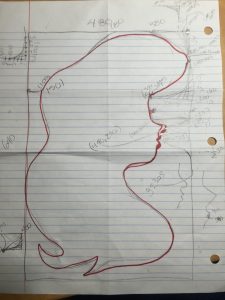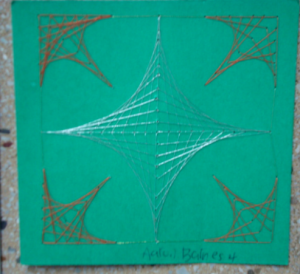I wanted to do a silhouette of Disney’s Ariel so I worked from a reference photo to sketch out the original plan. However, after I was done with the silhouette, I realized she looks more like Aurora. The overall coding was difficult but after I settled into a rhythm with her profile, it became a little easier.
Original sketch:
//Naomi Shimada
//Section D
//nshimada@andrew.cmu.edu
//Project-04
var y = 100;
var x = 150;
var a = 250;
var b = 225;
var c = 280;
var d = 250;
var e = 325;
var f = 320;
var g = 390;
var j = 400;
function setup() {
createCanvas(480,640);
background(0);
}
function draw() {
//right hand corner starting at (480,100)
for (var i = 480; i>380; i = i-3){
y = y-3;
stroke(255);
line(480,y,i,0);
}
//starts line of forehead
line(380,150,480,150);
//lower right hair swoop
while (x>100){
for (var z = 380; z<480; z = z+3){
stroke(255);
line(z,150,480,x);
x = x-3;
}
}
//lefthairswoop
for (var i = 0; i<280; i = i+3){
d = d-3;
stroke(255);
line(0,d,i,0);
}
//forehead
for (var i = 380; i<480; i = i+3){
line(i,150,i,225);
}
//nose
while (b<=230){
for (var i = 380; i<440; i = i+3){
line(i,225,i,b)
b = b+1;
}
}
for (var i = 440; i<480; i = i+3){
line(i,225,i,304);
}
while (a<280){
for (var i = 440; i>400; i = i-3){
line(i,a,i,304);
a = a+2;
}
}
//nose to lip
while (c<290){
for (var i = 400; i>390; i = i-3){
line(i,c,i,305);
c = c+2;
}
}
//upper lip
while (e>=320){
for (var i = 385; i<400; i = i+3){
line(i,f,i,e)
e = e-1;
f = f+1;
}
}
//filler background
for(var i = 400; i<480; i = i+3){
line(i,305,i,330);
}
//filler background
//for(var i = 385; i<400; i = i+3){
//line(i,390,i,344);
// }
//filler background
for(var i = 400; i<480; i = i+3){
line(i,331,i,390);
}
//lower right hair swoop
while (g>344){
for (var i = 375; i<400; i = i+3){
stroke(255);
line(i,390,400,g);
g = g-3;
}
}
//neck
while(j<600){
for(var i = 355; i<480; i = i+3){
line(i,390,i,j);
j = j + 3;
}
}
//eyelashes
push();
stroke(0);
strokeWeight(5);
line(380,190,390,185);
line(390,185,395,180);
pop();
push();
stroke(0);
strokeWeight(5);
line(378,190,390,175);
line(390,175,393,170);
pop();
}
![[OLD – FALL 2016] 15-104 • COMPUTING for CREATIVE PRACTICE](../../../../wp-content/uploads/2020/08/stop-banner.png)


